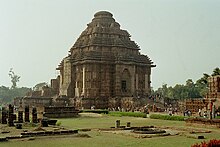
Deula is an architectural element in a Hindu temple in the Kalinga architecture style of the Odishan temples in Eastern India. Sometimes the whole temple is also referred to as Deula. The word "deula" in Odia language means a building structure built with a particular style that is seen in most of the temples from Odisha. Deul is also used in English, though the deul temples are also of a different form in the Manbhum region of Western Bengal.
There are three types of Deulas: In terms of the general north Indian terminology, the Rekha Deula (rekha deul) is the sanctuary and the tower over it, respectively the garbhagriha and the shikhara, the Pidha Deula (pida deul) is the mandapa where the faithful are present. The Khakhara deula is an alternative form of tower over the sanctuary, which in shape resembles the oblong gopuram temple gatehouses in southern Dravidian architecture.
Rekha Deula


Rekha in Odia means a straight line. It is a tall building with a shape of sugar loaf, looking like a Shikhara. It covers and protects the sanctum sanctorum (Garbhagriha). Examples :
- The Shikhara of the Lingaraja Temple in Bhubaneswar
- The Shikhara of the Jagannath temple in Puri
- Jagannath Temple in Nayagarh
- Uttaresvara Siva Temple in Bhubaneswar
- The Shikhara of Yameshwar Temple in Bhubaneswar
- The Shikhara of the Shantinath Shiva Temple at Shihar village near Jayrambati, Bankura, West Bengal
Pidha Deula

It is a square building, typically with a pyramid-shaped roof, rather like the vimana towers over the sanctuaries of temples in southern Dravidian architecture. For the halls or service rooms of the temple. Examples
- The Jagamohana (assembly hall) of the Sun temple in Konârak
- The Jagamohana of Yameshwara Temple in Bhubaneswar
- The Jagamohana of the Shantinath Shiva Temple in Jayrambati, Bankura, West Bengal
- Digambara Jaina Temple, Khandagiri in Bhubaneswar
Khakhara deula

Khakara deula is a rectangular building with a truncated pyramid-shaped roof, like the gopuras. The name comes from Khakharu (gourd) because of the shape of the roof. The temples of the feminine deities as Shakti are temple of that type. Examples :
- Baitala Deula, Bhubaneswar (dedicated to Chamunda)
- Varahi Deula, Chaurasi, Puri district (dedicated to Varahi)
- Brahmi temple, Chaurasi
- Kedara Gouri, Bhubaneswar
- Narayani Temple, Khalikote (dedicated to Durga)
- Durga Temple, Banki
References
- "Architecture on the Indian Subcontinent - Glossary". Retrieved 26 January 2007.
- Fergusson, James (2013). "ORISSA". History of Indian and Eastern Architecture. Cambridge: Cambridge University Press. pp. 92–116. doi:10.1017/cbo9781139814638.007. ISBN 9781139814638.
- http://orissa.gov.in/e-magazine/Orissareview/nov2005/engpdf/Orissan_Temple_Architecture.pdf p. 45-47
External links
- http://orissa.gov.in/e-magazine/Orissareview/nov2005/engpdf/Orissan_Temple_Architecture.pdf
- http://www.indoarch.org/arch_glossary.php
| Culture of Odisha | |||||||
|---|---|---|---|---|---|---|---|
| Dance |
| ||||||
| Music | |||||||
| Play, theatre and puppetry |
| ||||||
| Wedding | |||||||
| Festivals | |||||||
| Martial arts | |||||||
| Handlooms | |||||||
| Arts and Handicrafts |
| ||||||
| Architecture | |||||||
| Calendar (Panjika) | |||||||
This article about an Indian Hindu place of worship is a stub. You can help Misplaced Pages by expanding it. |